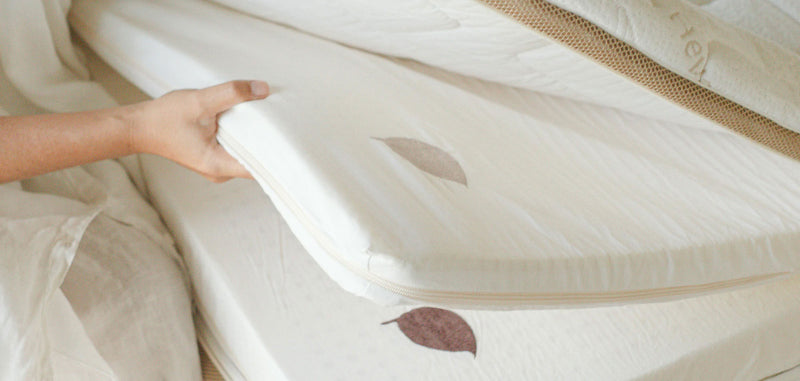Which is better for you, a natural latex mattress or a polyurethane (or PU) foam mattress? This is an important question for anyone thinking of buying a mattress. The answer is that the latex mattress is superior by far, but don't take our word for it. Let's carefully examine the evidence.
What is a latex mattress and how is it made?
A latex mattress is a natural product. The rubber tree (Hevea brasiliensis) produces a milky sap which is harvested and processed into blocks of latex foam. A latex mattress is therefore naturally springy without need for any springs, coils, or synthetic chemicals.

How would a latex mattress feel to me?
There is a huge demand for latex mattresses because of their excellent comfort and supportiveness. If you were to lie on a latex mattress, you would feel a comfortable softness that allows you to sink in, followed by a firmness which supports you fully in that soft comfort. However, there is more to the latex mattress than comfort, although of course comfort is the number one priority you are seeking in a mattress. Latex mattresses have excellent airflow properties, ideal for a warm humid climate like Singapore. Latex also is naturally mould resistant and dust mite resistant.
What is a polyurethane foam mattress and how is it made?
A polyurethane foam mattress (or PU) is also known as polyfoam. This is the most common type of mattress foam. It is often used as an upper comfort layer in innerspring mattresses. However, a big block of the foam can be used by itself as a polyurethane foam mattress.
At this point you may be wondering if polyurethane foam is similar to memory foam. In terms of feel, it is quite different. Both have polyurethane in them though. The main difference between polyurethane foam and memory foam is that memory foam contains additional chemicals which increase its density and viscosity. So they are chemically related, but feel vastly different to each other. PU foam is a lot more 'bouncy' or springy than memory foam.
Polyurethane foam is made entirely synthetically. There is no such thing as a natural PU mattress, in contrast to latex which can be 100% natural.

There are three main grades of polyurethane foam. These are regular grade, high density, and high resiliency. Regular grade and high density are not suitable for an entire mattress. Instead, they are often used as layers in the construction of other mattresses.
The high resiliency grade of PU foam is of much higher quality. It is processed slightly differently from other two grades and comes which a much higher support factor. In fact, a truly outstanding high resiliency PU mattress can nearly begin to approach latex in terms of its comfort.
However, it's important to note that high resiliency PU is quite expensive and therefore not readily used. If you are looking at a polyurethane foam mattress, it is wise to assume that it is one of the lower grades unless it is specifically labeled as high resiliency PU.
Advantages and disadvantages of a latex mattress
Advantages
- Unsurpassed comfort - latex mattresses offer outstanding comfort. Many people find that latex mattresses are able to alleviate pain when other mattresses are not.
- Naturally sourced product - latex comes from nature, unlike polyurethane. This makes latex very attractive to those with environmental concerns or who wish to avoid contact with harsh chemicals.
- Excellent support for body - latex excels at properly supporting the body and spine. In fact, many osteopaths and chiropractors recommend latex mattresses for this reason.
- Does not easily transmit movement - movement on one side of a latex mattress will not be felt easily on the other side.
- Naturally resistant to dust mites and mould - latex offers natural resistance to these, without the use of extra chemicals.
- Long lasting - a latex mattress is highly durable, outlasting other types of mattresses. This can offset its somewhat higher cost.
- Excellent ventilation - latex has a natural open cell structure which allows good air flow. Furthermore, latex mattresses contain pinholes created during the processing phase, which enhances air flow even further. This point is especially important in warm climates such as Singapore.
Disadvantages
- Cost - a latex mattress tends to be somewhat pricey.
Advantages and disadvantages of a polyurethane mattress
Advantages
- Polyurethane is relatively inexpensive - especially in the case of the lower grades of polyurethane mattresses. However, the best grade for sleeping on (the high resiliency grade) is a lot more expensive.
- Lightweight - a polyurethane mattress is one of the easiest to move or flip.
Disadvantages
- Poor support for spine or body - polyurethane foam does not support the body or spine properly.
- Not particularly comfortable - a polyurethane mattress does not feel especially comfortable. The high resiliency grade does a better job, but even then it does not match a latex mattress.
- Movement on one side is felt on the other - the very 'bouncy' nature of polyurethane foam means that any movement is transmitted throughout the whole mattress.
- Poorly ventilated - unlike latex, there is little to no airflow in a polyurethane mattress.
- Short lifetime - polyurethane foam breaks down quickly. It will need to be replaced much sooner than a latex mattress.
Not all foam mattresses are alike. Just because latex and polyurethane mattresses look like a foam block does not mean they will feel similar. Indeed, you need only to lie down on each of them once to realize immediately that you are dealing with two very different types of mattress.

Polyurethane foam is actually a very poor choice for a mattress on which you will be sleeping regularly. This is because it is one of the least comfortable types of mattresses and has one of the shortest lifetimes. A polyurethane mattress is not recommended for regular use. If you must have one, they are better as occasional-use mattresses, for example as a spare mattress for occasional short-stay guests. The lightweight portability of polyurethane foam means you can store the mattress out of the way when it is not being used, freeing up space. Even so, there are other inexpensive mattress types that would fulfill those needs and be much more comfortable for your short term guests.
Conclusion
As we can see from the above evidence, a latex mattress is clearly far superior in many different ways to a polyurethane mattress. Latex offers a lot of benefits beyond its outstanding comfort. The excellent airflow makes it ideal for warm climates like Singapore, and its natural mould resistance and dust mite resistance are additional advantages. Rest assured that the higher cost of a latex mattress is offset by its much longer lifetime. Also, a latex mattress offers unsurpassed comfort - and you can't put a price on that!















